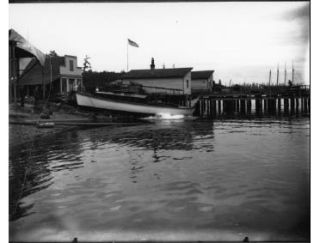Gliding a sailing dinghy on light breezes through Eagle Harbor offers a living library of maritime history. It’s an ever-changing panorama and feast for the eye.
When there is no wind, I use the sun. A photovoltaic, battery-powered electric motor slides us along so quietly that we have bumped into sleeping seals and heard otter families singing. Wind and sun seem the best way to fly.
I am not usually drawn to stink pots and power boats.Yet, this summer, one old wooden vessel at anchor caught my eye.
It was long, sleek and double ended – a classic and efficient form. Her white hull was blemished from rusting fastenings. She cried, “I need care!” What boat doesn’t? Her transom read: ZINA.
ZINA? A gimbaled, kerosene lamp went off in my head. ZINA! I recalled a photo of her at the Bainbridge Island Historical Museum. Wasn’t she built by Hall Brothers? Could we have a Hall Brothers’ boat here today?
Before I could find answers, island treasure Dave Ullin reported, “Phil Shivley towed ZINA out of the harbor yesterday!”
Phil reported, “ZINA went to Shilshole to be loaded for transport to Okanogan.”
“Okanogan?”
“That’s right,” owner Bob Morris of Eagledale told me. “She was built by Jimmy Hall here exactly 100 years ago. I tried to find a place to restore it on the Island. No place available. None.”
“What about the proposed Strawberry Cannery Park site?” I asked. “Folks have worked on boats there for over a century or more. It’s paved over. It wouldn’t contaminate anything. Restoring a Hall Brothers’ boat would be a terrific community project!”
“ZINA couldn’t wait,” Bob sighed. “And monthly fees in Port Townsend’s yards, not to mention time and energy wasted running back and forth, didn’t work for me. I did the math. I spend time at a retirement place with a barn near Brewster. It’ll be a fun project for me there!”
“Will she ever return to the salt water?” I pleaded.
“I hope so but there are some nice lakes over there and no barnacles!”
We scraped the surface of ZINA history and promised to meet the following week.
It was time to explore ZINA’s past. As if mining for “gweduc,” to unearth ZINA’s history we would also “dig deep.”
***
James Winslow Hall built ZINA. Born in 1864 in Chelsea, Mass., he was the only surviving son of Henry Knox Hall of Hall Brothers Shipyard fame.
“Jimmy” was Harvard educated, had ship-building genes, and joined his father at Port Blakely to learn about drafting, layout lofting, estimating, steam boilers, engines and some hands-on shipwright and cabinet making skills.
After the deaths of Henry’s last brothers, Isaac and Winslow, Henry formed a new firm, “Hall Brothers Marine Railway & Shipbuilding Co.” in Eagle Harbor.
It was a father-and-son team. Henry was a “robust” 73 years old when he moved here in the winter of 1902-1903. Jimmy joined him as manager for a year. A bachelor, Jimmy had a residence at the northeast corner of Ferncliff Drive and Hawley Way (recently demolished). John Hubbard became general manager in 1904.
The years that followed were busy as a toredo worm on an un-creosoted piling.
They created the new yard without creosote, installed the continent’s third largest marine railway, repaired and cleaned the bottoms of a zillion ships and built new ones. These included steamships Norwood, (1904, 845 ton), Cornell (aka James B. Stetson, 1905, 837 ton), Delhi (1906, 968 ton), Shana-Yak (700 ton), Arctic, A. B. Carpenter and a sternwheeler, W.H. Bancroft.
And Jimmy was commissioned by Western District Judge George Donworth of Seattle (1909-12) to build a pleasure cruiser that eventually would be named ZINA.
Respected West Coast naval architects Lee & Brinton of Seattle designed a 40-foot-long, narrow “hunting cabin launch.”
It was low to the water with a large covered cockpit – perfect for bagging a deer or bear unlucky enough to be spotted beachcombing. ZINA’s 16-horsepower gas engine would move her efficiently enough at 10 mph. Donworth wanted her for cruising and commuting to his summer home at Crystal Springs.
Jimmy accepted the commission and built ZINA of steam-bent oak ribs, fine fir planking and dark mahogany interior in a shed on the beach west of the Winslow Dock Store.
“Technically, ZINA wasn’t built within the shipyard proper,” Hall Brothers historian Gary White surmised. “I went aboard her in 1977 when she was at Gove’s Cove on Lake Union. She was gorgeous. I dreamed of owning her one day. So did everyone else.”
Gary was right. Bainbridge museum photos showed the instant of ZINA’s birth as she slid on greased ways and splashed seaward. A magnifier revealed a blurred name on the transom.
Donworth named her, though for whom, no one knows now. Graceful, fuel-efficient cruising awaited ZINA. So did a photographer and reporter from Pacific Motor Boat Magazine on July 25, 1908. Hall’s fine woodwork caught West Coast boaters’ eyes.
Jimmy’s father died the following year. Donworth sold ZINA to William Milo Meacham for $800 sometime between 1910 and 1912.
In the Bainbridge Historical Museum, visitors marvel at the famous giant panorama behind the entry desk. It was taken circa 1914.
From the foot of Madison, it looks across a harbor filled with dozens of tall ships tied to Eagledale trees while waiting out economic doldrums. There are more to the east at Jimmy Hall’s shipyard. And there, among the sleeping giants of sail, rests what seems a tiny yacht at anchor – ZINA!
In 1916, Jimmy sold the shipyard before the toredos devoured it. The story of Hall Brothers ends just as ZINA’s amazing tale is about to begin.
(To be continued.)
Jerry Elfendahl is an island writer and historian.



